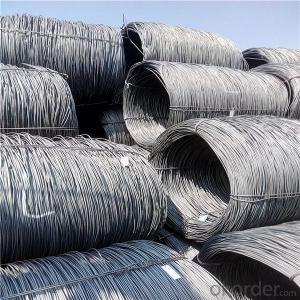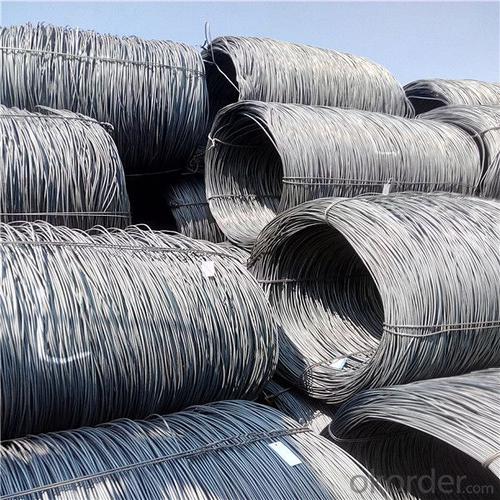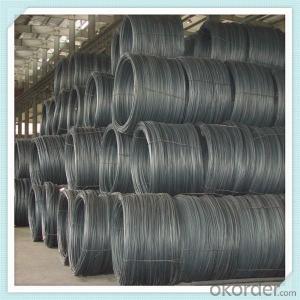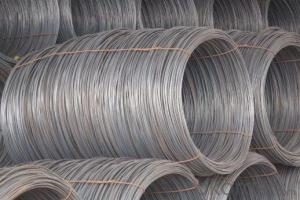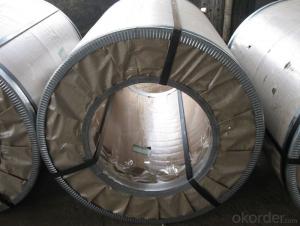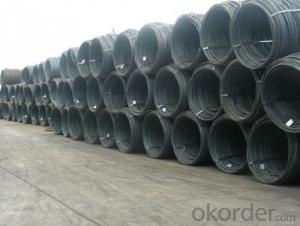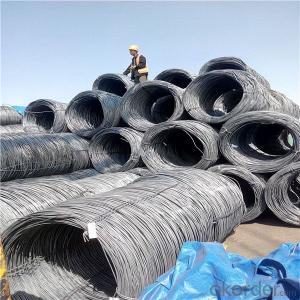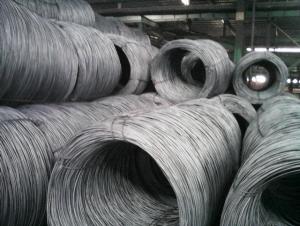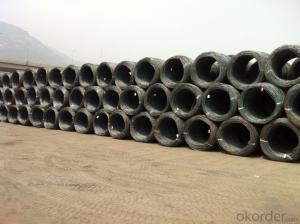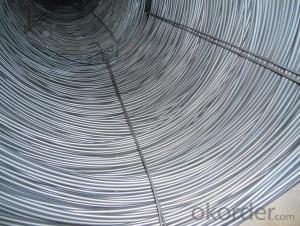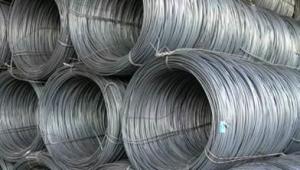Low carbon steel wire coil from china mill
- Loading Port:
- Guangzhou
- Payment Terms:
- TT OR LC
- Min Order Qty:
- 50 m.t.
- Supply Capability:
- 13210 m.t./month
OKorder Service Pledge
OKorder Financial Service
You Might Also Like
Specification
Produced from billets at the rolling mill, wire rod is the basis of all steel wire, rope and fencing products.
The most important characteristic in determining wire rod’s end use is its drawability. Common low carbon
wire rod is used for nails, small shaped products, barbed wires, various wire nettings, steel chains, and other
applications. High Carbon wire rod uses include steel tire cords for automobiles, conveyor belts, and pressure
hoses. Other applications include bolts, nuts, and machine parts, as well as compression, tension and torsion
springs
Mainly used in building and construction as binding wire, tie wire and baling wire; also can be make for wire mesh
Our service:
(1) We cooperate with famous factories with advanced equipment and well trained workers.
(2) We can provide factory price with trading company service.
(3) We continuously work on the improvement of our processes, guaranteeing
consistently high standards of quality to keep none compensation.
(4) We guarantee 24 hours response and 48 hours solution providing service.
(5) We accept small order quantity before formal cooperation.
(6) We deliver the agreed quality at the agreed time, reacting to changes in
customer wishes in a flexible way.
(7) Due to our volume and selling power, we have excellent freight rates with
shipping lines.
(8) We strive to always be fair and honest in our dealings with customers.
(9) We strive to work together with customers to achieve much more than we can
achieve alone.
(10) Through our passion and commitment we aim to be a market leader in all our
key markets. To maintain our position as market leader we must continue to add
value in all that we do.
Product Description :
Standard | AISI, ASTM, BS, DIN, GB, JIS |
Material/steel grade | Q195-Q235,SAE1006B,SAE1006CR, SAE1008B, SAE1008CR, SAE1010B, SAE1018B, or according to customers requirements |
Wire Gauge | 5.5-12mm |
Coil weight | 1.8-2.1mts |
MOQ | 25MT |
Delivery Time | 15-30 days after receipt of L/C or deposit by T/T |
Packing | In coil and load in container, if large quantity, by bulk vessel; Can be packed as customers' special requirements |
Payment terms | 1).100% irrevocable L/C at sight. 2).30% T/T prepaid and the balance against the copy of B/L. 3).30% T/T prepaid and the balance against L/C |
Application | widely used in machinery parts, manufacturing industry, electronics industry, metal tools and others |
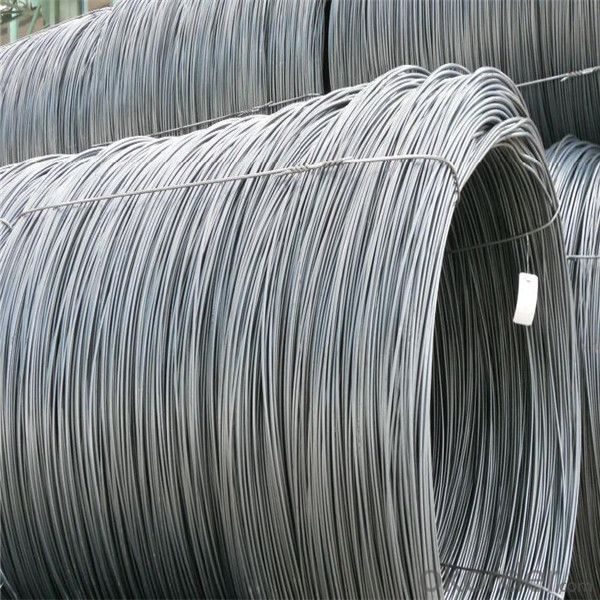
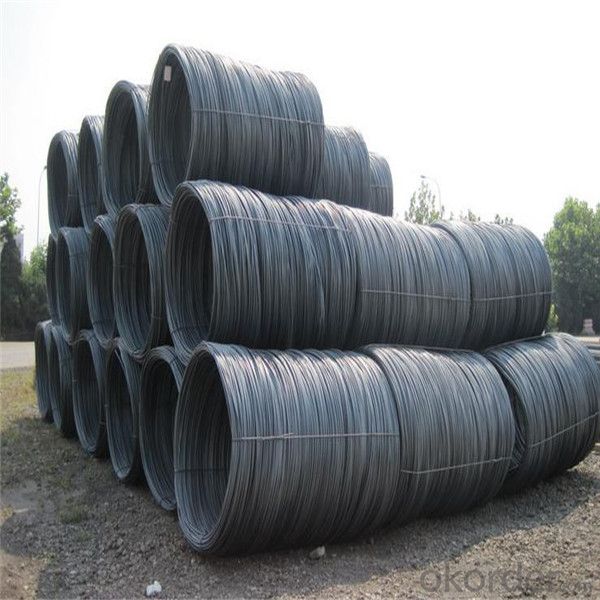
Application :
Mainly used in building and construction as binding wire, tie wire and baling wire; also can be make
for wire mesh.
Packing :
Hot-rolled wire rod is held in a unit with at least four steel straps in the
transverse direction and transported and stored without further packaging.
Before
the steel strapping is applied, the wire rod must be sufficiently compressed.
The strapping is fixed in the transverse direction with a single circumferential
strap so that the strapping does not slip and cause the coil to come apart.
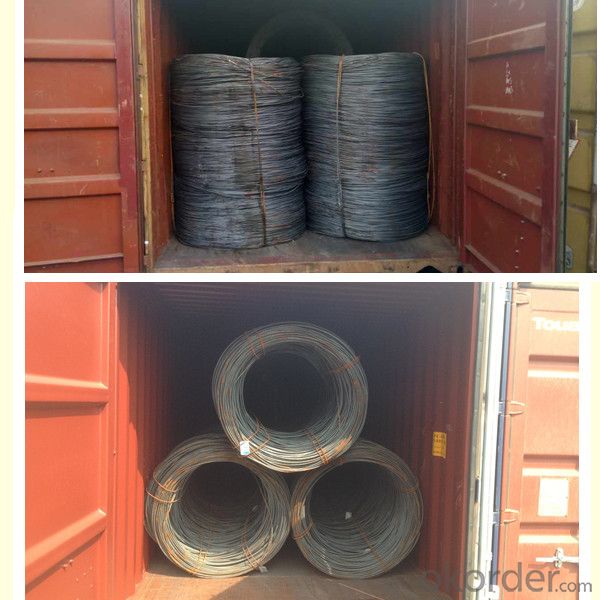
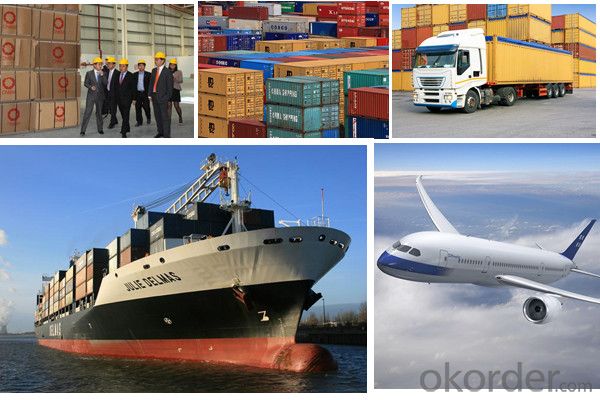
FAQ:
1.Q:Can you accept mixed order?
A: Yes, mixed acceptable .
2. Q: How can I buy CNBM products in my country?
A:Please send us an inquiry or email ,we will reply to you if there is distributor in your country
3. Q: Can we visit your factory?
A: Warmly welcome. Once we have your schedule, we will arrange the
professional sales team to follow up your case.
4. Q: How long does it take to get the product if i place an order?
A:With the process of your requirements,we will pack and deliver in 3
-7 days. If it is by sea shipment,it will take 15-45 days depending on different locations
- Q: How does the tensile strength of steel wire rod vary with different diameters?
- The tensile strength of steel wire rod can vary with different diameters. Generally, as the diameter of the wire rod increases, the tensile strength also tends to increase. This is because a larger diameter provides more surface area for the material to resist deformation under tension. Additionally, a larger diameter wire rod typically contains more material, resulting in a stronger overall structure. However, it is important to note that the relationship between diameter and tensile strength is not linear. At a certain point, increasing the diameter of the wire rod may not significantly increase its tensile strength. This is because the material properties of the steel can also influence its strength. For instance, the grade of steel, its microstructure, and any additional treatments or heatings can affect the overall strength of the wire rod. It is also worth mentioning that other factors, such as the manufacturing process and any subsequent treatments, can also influence the tensile strength of steel wire rod. These factors include drawing processes, heat treatments, and alloying elements. Therefore, when considering the tensile strength of steel wire rod with different diameters, it is essential to take into account all these factors to accurately determine the relationship between diameter and tensile strength.
- Q: How is steel wire rod used in the production of wire brushes?
- Steel wire rod is used in the production of wire brushes as the primary material for the bristles. It is shaped and twisted into the desired brush pattern, providing strength and durability to effectively clean and remove dirt, debris, or rust from various surfaces.
- Q: How is steel wire rod used in the manufacturing of wire for electrical heating cables?
- Steel wire rod is an indispensable element in the wire manufacturing process for electrical heating cables. The wire rod acts as the main raw material that undergoes different treatments and changes to produce the final wire for electrical heating cables. To start with, the steel wire rod is typically made from low-carbon steel, which possesses exceptional electrical conductivity and resistance to heat. This makes it a perfect material for electrical heating cables as it can efficiently conduct electricity and endure the high temperatures generated by the cables. The initial step in the manufacturing process involves hot rolling the steel wire rod into a thin strip, which is then cold drawn to achieve the desired wire diameter. This cold drawing process gives the wire high tensile strength and flexibility, ensuring its ability to withstand stress and strain in various applications. Once the wire is formed, it undergoes a series of heat treatments to enhance its electrical conductivity and heat resistance. This may include annealing, where the wire is heated and slowly cooled to relieve internal stresses and improve its ductility. Additionally, the wire may undergo galvanization, a process in which a protective layer of zinc is applied to enhance its resistance to corrosion. After the heat treatments, the wire is further processed to meet the required specifications for electrical heating cables. This may involve additional drawing processes to achieve the desired diameter and surface finish. The wire is then wound onto spools or coils, ready to be used in the manufacturing of electrical heating cables. In the final stage of the manufacturing process, the steel wire is incorporated into the construction of electrical heating cables. This usually involves combining the wire with other materials, such as insulation and protective sheathing, to ensure the safety and functionality of the cables. Overall, steel wire rods have a vital role in the manufacture of wire for electrical heating cables. Its outstanding electrical conductivity, heat resistance, and strength make it an ideal material for this application. Through different treatments and processes, the steel wire rod is transformed into a high-quality wire that can efficiently conduct electricity and withstand the demanding conditions of electrical heating systems.
- Q: What are the different types of wire drawing dies used for steel wire rod?
- There are several types of wire drawing dies that are commonly used for steel wire rod. These include: 1. Single crystal natural diamond dies: These dies are made from a single crystal diamond and are known for their high hardness and wear resistance. They can be used for drawing high carbon steel wire rod as well as stainless steel wire rod. 2. Polycrystalline diamond (PCD) dies: PCD dies are made from multiple small diamond crystals that are bonded together. They offer good wear resistance and can be used for drawing steel wire rod with intermediate carbon content. 3. Tungsten carbide dies: Tungsten carbide is a hard and durable material that is often used for wire drawing dies. These dies can handle high carbon steel wire rod and are known for their ability to withstand high pressures and temperatures. 4. Natural diamond dies with carbide support: These dies have a natural diamond core with a carbide support structure. The diamond provides excellent wear resistance while the carbide support adds strength and stability. They are suitable for drawing steel wire rod with high carbon content. 5. PCD dies with carbide support: Similar to the above, these dies have a PCD core with a carbide support structure. They offer good wear resistance and can handle steel wire rod with intermediate carbon content. 6. Polycrystalline diamond composite (PDC) dies: PDC dies are made by sintering diamond particles with a binder material. They are known for their high wear resistance and are often used for drawing steel wire rod with low to medium carbon content. Each type of wire drawing die has its own advantages and is suitable for specific applications based on the carbon content and other properties of the steel wire rod being drawn.
- Q: How is steel wire rod used in the production of wire shelves and racks?
- Steel wire rod is an essential component in the production of wire shelves and racks. It serves as the primary material from which the wire shelves and racks are constructed. Firstly, the steel wire rod is processed and drawn to achieve the desired shape and size for the wire shelves and racks. This process involves passing the wire rod through a series of dies and rollers to transform it into a thinner and more malleable wire form. Once the wire is drawn, it is then bent, cut, and welded to create the necessary components of the wire shelves and racks. The wire rods are shaped into grids, frames, and supports, which form the basic structure of the shelves and racks. The wire rods are also used to create the mesh or grid patterns that make up the shelving surfaces. These grids allow for the storage of various items without the risk of them falling through the gaps. Furthermore, the steel wire rod provides strength and durability to the wire shelves and racks. Its high tensile strength ensures that the shelves can withstand heavy loads without bending or breaking. This makes them suitable for industrial use where heavy items need to be stored. In addition, the steel wire rod is often coated or galvanized to enhance its corrosion resistance. This coating protects the wire shelves and racks from rust and other forms of degradation, thereby prolonging their lifespan and maintaining their appearance. Overall, the use of steel wire rod in the production of wire shelves and racks is crucial. It provides the necessary strength, durability, and functionality required for effective storage solutions in various settings, including homes, offices, warehouses, and retail spaces.
- Q: How is the steel wire rod market affected by fluctuations in foreign exchange rates?
- Fluctuations in foreign exchange rates have a notable influence on the steel wire rod market. Given its highly globalized nature, steel wire rod is frequently traded internationally, and its prices are subject to currency exchange rate fluctuations. When a country's currency weakens against major foreign currencies, its exports become more competitive in international markets. This, in turn, can spur demand for steel wire rod from that country, as it becomes more affordable for foreign buyers. Consequently, the steel wire rod market experiences an upswing in sales, potentially leading to price increases due to heightened demand. Conversely, when a country's currency strengthens, its exports become pricier for foreign buyers. This can result in decreased demand for steel wire rod from that country, leading to lower sales and potential price reductions. Fluctuations in foreign exchange rates can introduce uncertainty and volatility to the steel wire rod market, making it challenging for manufacturers, suppliers, and distributors to plan and forecast their operations effectively. Moreover, currency fluctuations can impact the cost of raw materials and production processes. Steel wire rod manufacturers often rely on imported raw materials, such as iron ore and scrap metal, which are priced in foreign currencies. If a country's currency weakens, the cost of importing these raw materials may rise, resulting in higher production costs and potentially increased steel wire rod prices. Additionally, foreign exchange rates affect the competitiveness of steel wire rod imports. A higher-valued currency makes it more cost-effective to import steel wire rod from other countries. Consequently, this can instigate heightened competition for domestic manufacturers, potentially leading to reduced market share and profitability. To summarize, fluctuations in foreign exchange rates have a significant impact on the steel wire rod market. They influence the competitiveness of exports, the cost of raw materials, the pricing of steel wire rod, and the competitiveness of imports. Participants in the steel wire rod market must vigilantly monitor and analyze foreign exchange rates to effectively anticipate and respond to market dynamics.
- Q: How is steel wire rod used in the manufacturing of wire for automotive airbags?
- Steel wire rod is an essential component in the manufacturing process of wire for automotive airbags. The wire rod serves as the raw material that is transformed into the final wire used in the airbag system. Firstly, the steel wire rod goes through a series of processes to enhance its properties and make it suitable for airbag wire manufacturing. These processes include cleaning, heating, and shaping the rod into the desired diameter and shape. The rod may also undergo surface treatments to improve its corrosion resistance and strength. Once the rod is prepared, it is then drawn through a series of dies to reduce its diameter and increase its length. This process, known as wire drawing, significantly improves the wire's strength and flexibility. The wire is typically drawn several times to achieve the required diameter and mechanical properties. After the wire drawing process, the wire is further processed to ensure it meets the specific requirements of automotive airbags. It may undergo additional heat treatments to enhance its strength and ductility, making it capable of withstanding the forces exerted during airbag deployment. The final wire produced from the steel wire rod is then used in the fabrication of the airbag system. The wire is typically woven or knitted to form a strong and flexible fabric that can expand rapidly upon airbag deployment. This fabric is then incorporated into the airbag module, which also includes other components such as the inflator and cushion. Overall, steel wire rod plays a crucial role in the manufacturing of wire for automotive airbags. It provides the raw material that is processed and transformed into the final wire, which is strong, flexible, and capable of effectively protecting occupants in the event of a collision.
- Q: How is steel wire rod used in the manufacturing of wire forms for sliding doors?
- The manufacturing of wire forms for sliding doors relies heavily on steel wire rod. It acts as the main material for constructing the framework and structure of the wire forms. To begin with, steel wire rod is chosen for its exceptional tensile strength and durability, making it ideal for withstanding the constant movement and stress experienced by sliding doors. The wire rod undergoes a series of processes, including drawing and annealing, to enhance its mechanical properties and ensure it meets the necessary specifications. Following that, the steel wire rod is shaped into various sizes and shapes based on the specific design and requirements of the wire forms. This can be accomplished through techniques such as bending, cutting, and welding. The wire rod is manipulated to create the required curves, angles, and dimensions needed for constructing the sliding door wire forms. Once the wire forms are shaped, they undergo further processing to enhance their functionality and aesthetics. This may involve surface treatments like galvanizing or coating to provide corrosion resistance and improve the overall appearance of the wire forms. Lastly, the wire forms are assembled and integrated into the sliding door system. They are commonly used to support the door panels, guide the movement of the doors along the tracks, and provide stability and smooth operation. The steel wire rod ensures that the wire forms can endure the weight of the door panels and withstand frequent opening and closing without deforming or failing. In conclusion, steel wire rod plays a crucial role in the manufacturing of wire forms for sliding doors by providing strength, durability, and flexibility. It serves as the foundation of the wire forms, enabling them to function effectively and contribute to the overall performance of sliding doors.
- Q: What are the different machinability testing methods for steel wire rod?
- Steel wire rods have several available methods for testing their machinability, including: 1. The turning test involves using a lathe or turning machine to machine the steel wire rod. The cutting speed, feed rate, and depth of cut are adjusted to evaluate the material's machinability. The machinability characteristics are assessed by observing and analyzing tool wear, surface finish, and chip formation. 2. The drilling test uses a drilling machine to create holes in the steel wire rod. The cutting speed, feed rate, and drill geometry are modified to determine the machinability. The performance of the material during drilling is evaluated by examining hole quality, chip formation, and tool wear. 3. Tapping is a common machining operation performed on steel wire rods to create threaded holes. The tapping test involves tapping the steel wire rod using a tapping tool. The machinability of the material is determined by assessing the torque required, tool life, and thread quality. 4. Grinding is a precision machining process used to remove material from the steel wire rod. The grinding test includes grinding the steel wire rod using a grinding wheel or abrasive belt. The machinability is evaluated by adjusting the grinding speed, feed rate, and grinding wheel specification. The performance of the material during grinding is analyzed by examining surface roughness, material removal rate, and grinding wheel wear. 5. The hardness test indirectly assesses machinability by measuring the hardness of the steel wire rod. Hardness is an important mechanical property that affects machinability. Various hardness testing methods, such as Rockwell, Brinell, or Vickers hardness tests, can be performed to determine the hardness of the steel wire rod. Higher hardness values indicate lower machinability, while lower hardness values suggest better machinability. These testing methods assist manufacturers and engineers in selecting the most appropriate machining parameters and tools for processing steel wire rods. By understanding the machinability characteristics, they can optimize machining operations, improve productivity, and minimize tool wear and material waste.
- Q: What are the common industry regulations for steel wire rod?
- The common industry regulations for steel wire rod vary depending on the country and region. However, some of the most common regulations include standards for dimensions, chemical composition, mechanical properties, and surface conditions of steel wire rod. These regulations aim to ensure the quality, safety, and proper use of steel wire rod in various industries such as construction, automotive, and manufacturing. Compliance with these regulations is crucial for manufacturers and suppliers to meet customer requirements and maintain industry standards.
Send your message to us
Low carbon steel wire coil from china mill
- Loading Port:
- Guangzhou
- Payment Terms:
- TT OR LC
- Min Order Qty:
- 50 m.t.
- Supply Capability:
- 13210 m.t./month
OKorder Service Pledge
OKorder Financial Service
Similar products
Hot products
Hot Searches
Related keywords
